Brittany A. Roston - Sep 30, 2021

NASA is wrapping up the final tasks that must be completed ahead of the Lucy mission launch scheduled for October, the space agency has announced. The Lucy mission has been a work-in-progress for some time now, but the rewards for this effort are nearer than ever. NASA plans to launch the Lucy spacecraft on October 16, sending it off on a mission to study eight never-before-seen Trojan asteroids around Jupiter.
With all the other prep work out of the way, NASA says the team is preparing to put Lucy in its capsule for launch. This will be the first spacecraft to visit the Trojan asteroids, which both lead and follow Jupiter as it moves around the Sun. It has taken the last eight weeks to prep Lucy for its launch next month, including testing its various electrical, mechanical, and thermal systems, as well as practicing the launch sequence we’ll see on October 16.
The mission is a promising one that will, hopefully, help shed light not only on the origins of the Trojan asteroids but also how the planets in our solar system formed long ago. The spacecraft is equipped with massive solar arrays to power its instruments, while recently added fuel — about 1,600lbs of it — will propel Lucy to its destination.
Once fully encapsulated, Lucy will be shuttled to Cape Canaveral Space Force Station. United Launch Alliance’s Atlas V 401 rocket will send Lucy to space, something that will — assuming there aren’t any delays — happen around 5:34 AM ET. As with other launches, it is possible weather issues could bump the event to the next day.
Lucy was built by Lockheed Martin as the 13th spacecraft under NASA’s Discovery Program. Among other things, Lucy will be notable as the first spacecraft to make multiple circles back near Earth as part of its mission, something intended to give it “gravity assists.”
Story Timeline
NASA Lucy mission integrates its second scientific instrument
NASA's Lucy spacecraft gets two very special cameras to go asteroid hunting
NASA Lucy spacecraft solar panel deployment test goes off without a hitch
NASA's Lucy mission toward Jupiter will explore eight never-before-seen worlds
The upcoming momentous mission to the Trojan belt could rewrite our knowledge about the origins of planets. Here's everything you need to know.
Monisha Ravisetti
Sept. 30, 2021
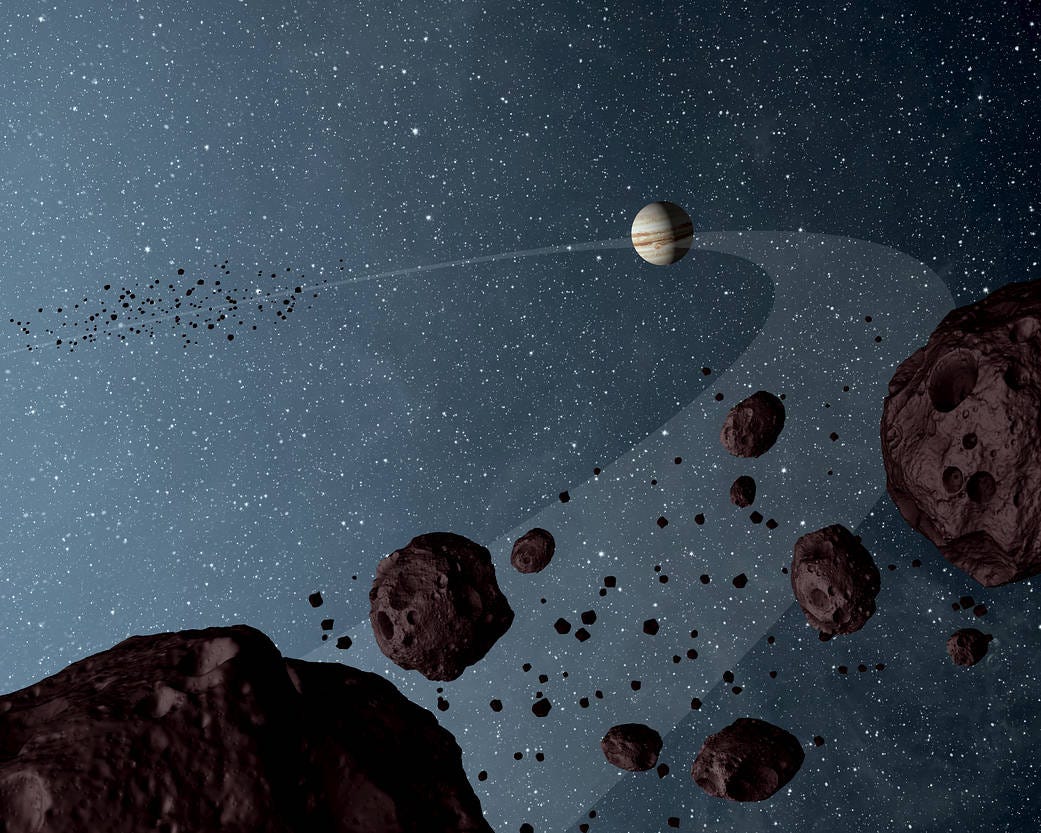
An artist's concept of Jupiter's Trojan asteroids. Recent results suggest the rocks are uniformly dark with a hint of burgundy. NASA
Far out in Jupiter's orbit lie the Trojan asteroids -- fossils from the rock collection that spawned the giant planets over 4 billion years ago. These hovering time capsules could hold keys that unlock the origins of Earth, Saturn and Mars.
And in a couple of weeks, NASA's Lucy mission is sending a spacecraft toward the ancient raw materials in an ambitious and daring attempt to access our solar system's well-preserved history.
Perfectly named for the fossil that taught us about humanity's genesis, Lucy's 12-year-long trek promises to reveal a cosmic evolutionary record. The spacecraft will catch close-up views of a diverse selection of Trojan asteroids to help scientists decipher how and why our solar system's planets came to be.
Right now, we know close to nothing about these primitive rocks' properties. But we've rounded up everything we can to help you prepare for the momentous launch.
Cue "Lucy in the sky with diamonds."
How to watch NASA launch the Lucy mission
You can watch the take-off scheduled for Oct. 16 at 2:34 a.m. PT (5:34 a.m. ET) online on NASA TV.
Make sure to check back closer to the big day for a livestream on CNET Highlights, but first, let's dive into why this mission could be life-changing for the astronomy field.
What are the Trojan asteroids?
Long before planets came into existence, the solar system overflowed with trillions of rocky and icy bodies orbiting a dim sun. Some of these fragments slowly fused together to form larger planets, such as the Earth and Mars. But along the way, a bunch of floating rocks were left over.
Many were swept into the endless depths of the universe -- taking their secrets with them -- but a smattering still live in the outer reaches of our solar system.
Caught between the gravitational pull of the sun and Jupiter are these primitive pieces of rock that have been around for billions of years. They're known as Jupiter's Trojan asteroids. NASA aptly refers to them as "time capsules from the birth of our solar system" and they form two clusters that share an orbit with the gas giant. Over 7,000 have been detected, so far.
"The stuff that went into growing Jupiter and Saturn are now trapped in these locations," NASA planetary scientist and principal investigator of the Lucy mission, Hal Levison, said in the mission's overview.
Where does Lucy come in?
Lucy will be the first spacecraft to asteroid-hop among seven of the Trojan asteroids, but before heading to both the leading and trailing swarms, it'll visit a main belt asteroid located between Mars and Jupiter.
In green, you see the leading and trailing swarms of Jupiter Trojans. That's where Lucy is headed.NASA
"We're going to eight never-before-seen asteroids in 12 years with a single spacecraft," Tom Statler, Lucy project scientist at NASA headquarters in Washington said in a statement. "This is a fantastic opportunity for discovery as we probe into our solar system's distant past."
NASA notes that "no other space mission in history has been launched to as many different destinations in independent orbits around our sun" and that "Lucy will show us, for the first time, the diversity of the primordial bodies that built the planets."
The spacecraft will use traditional chemical propulsion technology that'll help with maneuvering, but to save fuel, it'll fly past points of interest instead of treading slowly. That doesn't pose much of a hindrance, though, because Lucy can still snap pics and collect spectroscopic information while whizzing by.
Mission objectives
Armed with a high-gain antenna for communication with Earth; high-tech cameras (color, as well as black and white); an infrared spectrometer and thermometer, the spacecraft will check out several key features of these asteroids by capturing their physical properties:
Surface geology: This includes things like shape, crater size, crustal structure and layering.
Surface color and composition: Tones and colors of the rocks, mineral makeup and regolith properties, such as loose soil composition, are some of these features.
Interiors and bulk properties: Masses, densities, powder blankets around craters and other nitty gritty details comprise this section.
Satellites and rings: A few of the asteroids might have mini-asteroids orbiting them, as though they're the center of their own solar system. Some might even have Saturn-like rings consisting of super small rocks or icy bodies.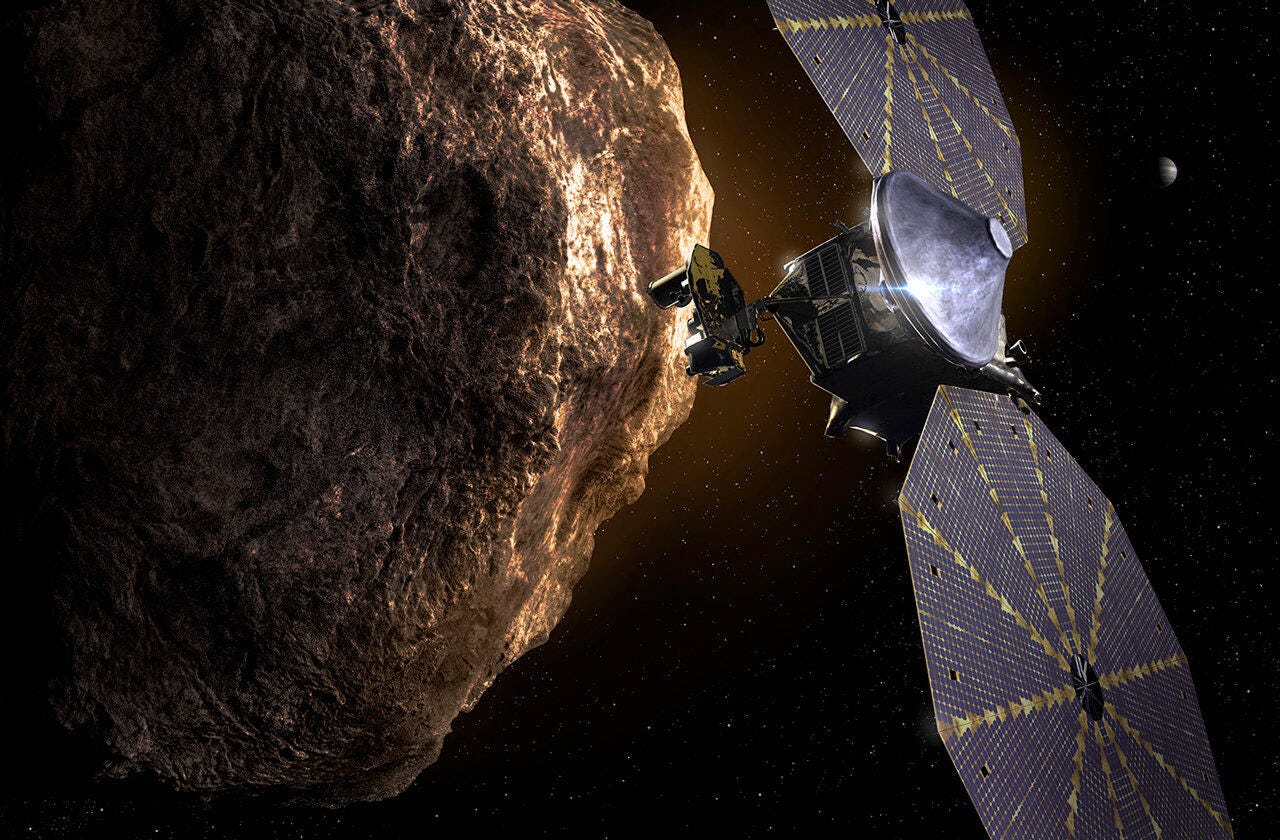
NASA's Lucy will explore eight asteroids over a dozen years.NASA
Prepping for take-off
It isn't easy being a NASA probe.
Because Lucy will rely on solar power for the mission, its arrays -- large enough to cover a five story building -- had to undergo intense testing to ensure they won't malfunction during spaceflight. They're so huge because of how far the probe will be traveling from the sun.
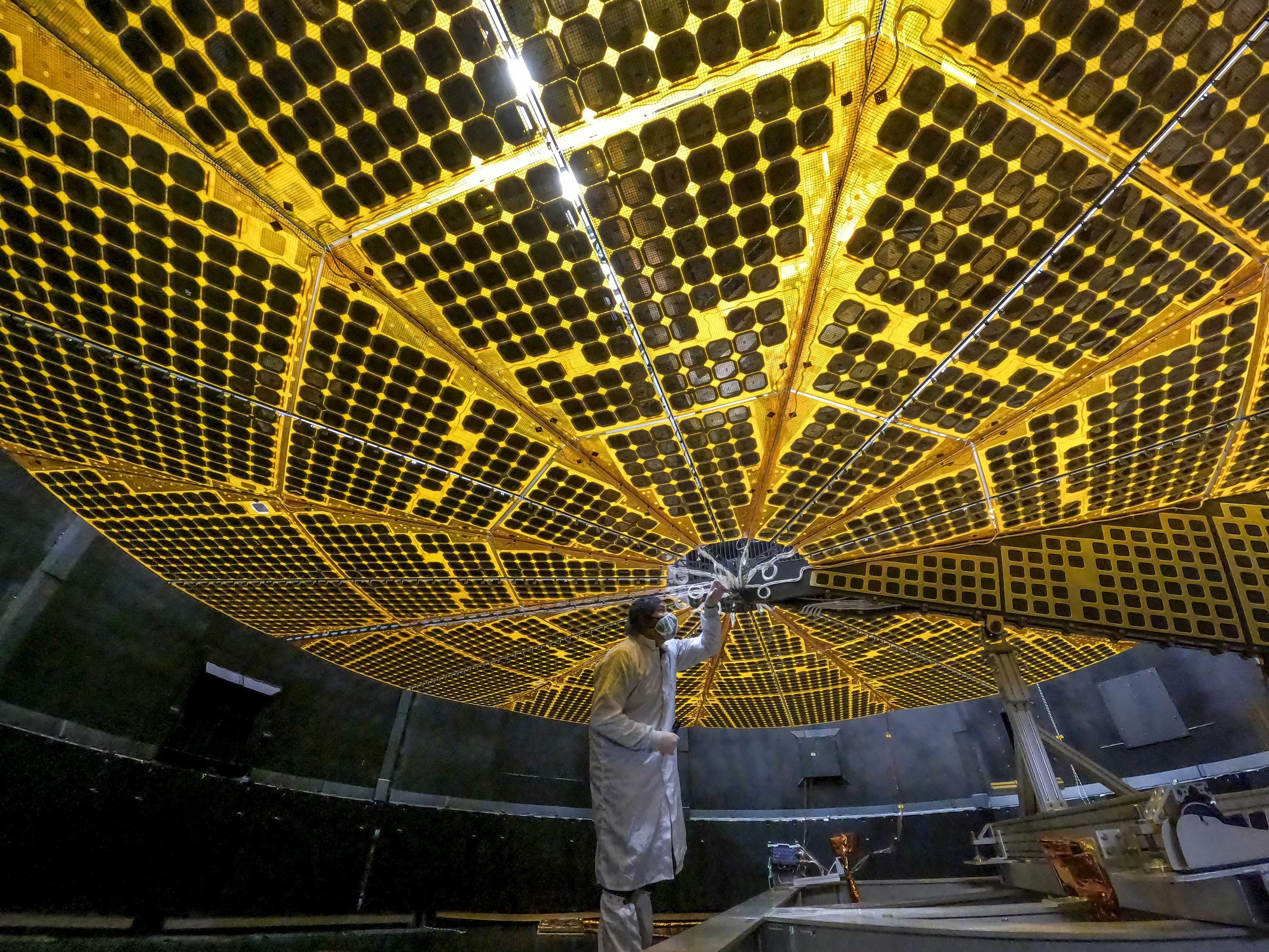
A researcher working on Lucy's solar panels.NASA
According to NASA, it will take a total of 20 minutes for these crucial solar panels to extend after launch. "These 20 minutes will determine if the rest of the 12 year mission will be a success," Levison said in a statement.
Mars rovers, such as Perseverance, have shorter spans of anxiety-inducing moments during their EDL phase, or entry, descent and landing sequence.
"Mars landers have their seven minutes of terror, we have this," Levison remarked.
After several iterations of testing, Donya Douglas-Bradshaw, Lucy project manager from NASA's Goddard Space Flight Center in Greenbelt, Maryland, said in a statement that the execution on the ground was "flawless."
Although space is a very different arena.
On Oct. 16, Lucy will be transported to the Vehicle Integration Facility at the Cape Canaveral Space Force Station and "mated" with the United Launch Alliance Atlas V rocket. That rocket will help Lucy exit Earth's atmosphere.
Then, Lucy will propel away from our home planet to begin the 12-year voyage, swinging around the solar system, using Earth's gravity as leverage three times during the journey.
"Launching a spacecraft is almost like sending a child off to college -- you've done what can for them to get them ready for that next big step on their own," Levison said.
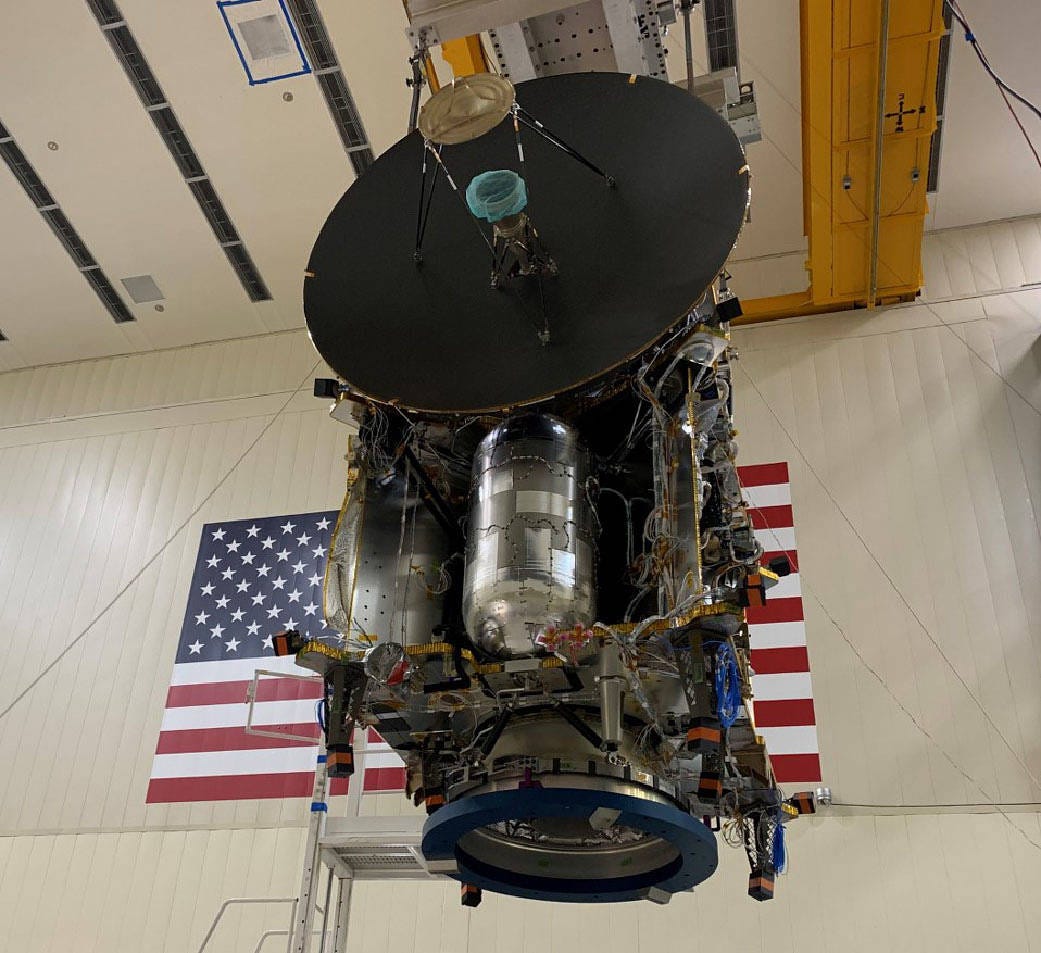
Lucy stands 13 feet (4 meters), nearly fully assembled in this photo.NASA
What will happen after the mission is complete?
After a dozen years, Lucy will stabilize near Earth, then crusade once again to the Trojan asteroid belt. It'll be the first ever spacecraft to travel all the way to Jupiter and back home.
Future humans will face two options: collect Lucy as an artifact and bring it down to Earth, or allow Jupiter to eventually fling it into the sun or out of the solar system.
Not to fear. Lucy's job will be complete by then. And perhaps our astronomy textbooks will be amended with the unprecedented information it delivers home.
NASA Lucy mission will carry words of Einstein, Carl Sagan and Beatles into space
Lucy in the darkness of space with John, Paul, George and Ringo.
Amanda Kooser
Sept. 29, 2021
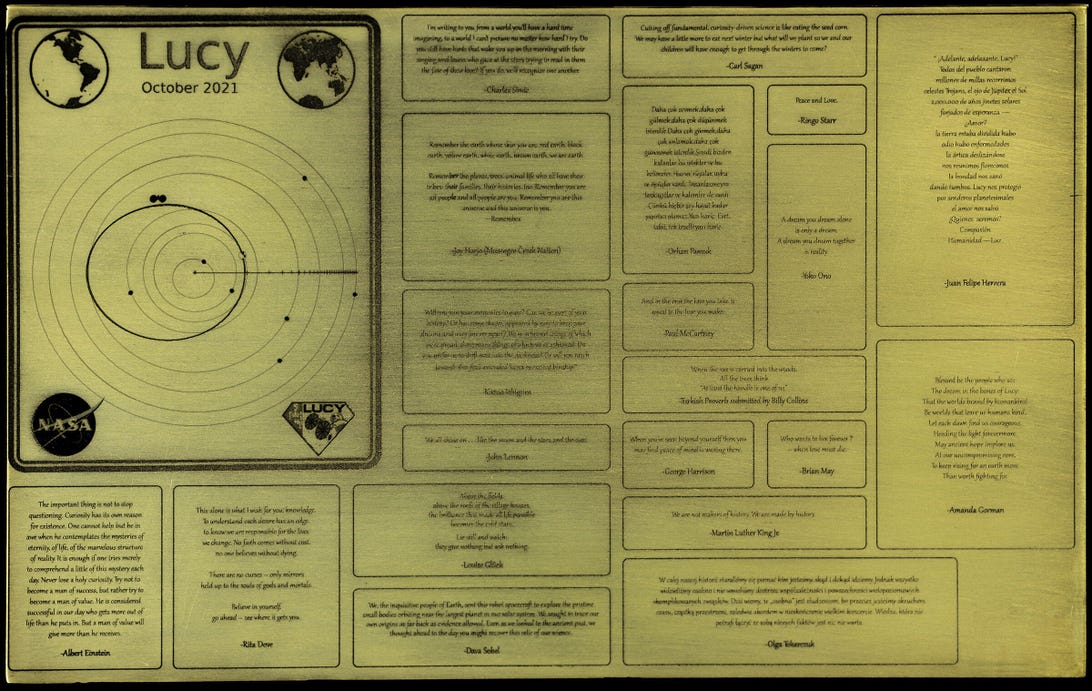

The upcoming momentous mission to the Trojan belt could rewrite our knowledge about the origins of planets. Here's everything you need to know.
Monisha Ravisetti
Sept. 30, 2021

An artist's concept of Jupiter's Trojan asteroids. Recent results suggest the rocks are uniformly dark with a hint of burgundy. NASA
Far out in Jupiter's orbit lie the Trojan asteroids -- fossils from the rock collection that spawned the giant planets over 4 billion years ago. These hovering time capsules could hold keys that unlock the origins of Earth, Saturn and Mars.
And in a couple of weeks, NASA's Lucy mission is sending a spacecraft toward the ancient raw materials in an ambitious and daring attempt to access our solar system's well-preserved history.
Perfectly named for the fossil that taught us about humanity's genesis, Lucy's 12-year-long trek promises to reveal a cosmic evolutionary record. The spacecraft will catch close-up views of a diverse selection of Trojan asteroids to help scientists decipher how and why our solar system's planets came to be.
Right now, we know close to nothing about these primitive rocks' properties. But we've rounded up everything we can to help you prepare for the momentous launch.
Cue "Lucy in the sky with diamonds."
How to watch NASA launch the Lucy mission
You can watch the take-off scheduled for Oct. 16 at 2:34 a.m. PT (5:34 a.m. ET) online on NASA TV.
Make sure to check back closer to the big day for a livestream on CNET Highlights, but first, let's dive into why this mission could be life-changing for the astronomy field.
What are the Trojan asteroids?
Long before planets came into existence, the solar system overflowed with trillions of rocky and icy bodies orbiting a dim sun. Some of these fragments slowly fused together to form larger planets, such as the Earth and Mars. But along the way, a bunch of floating rocks were left over.
Many were swept into the endless depths of the universe -- taking their secrets with them -- but a smattering still live in the outer reaches of our solar system.
Caught between the gravitational pull of the sun and Jupiter are these primitive pieces of rock that have been around for billions of years. They're known as Jupiter's Trojan asteroids. NASA aptly refers to them as "time capsules from the birth of our solar system" and they form two clusters that share an orbit with the gas giant. Over 7,000 have been detected, so far.
"The stuff that went into growing Jupiter and Saturn are now trapped in these locations," NASA planetary scientist and principal investigator of the Lucy mission, Hal Levison, said in the mission's overview.
Where does Lucy come in?
Lucy will be the first spacecraft to asteroid-hop among seven of the Trojan asteroids, but before heading to both the leading and trailing swarms, it'll visit a main belt asteroid located between Mars and Jupiter.
In green, you see the leading and trailing swarms of Jupiter Trojans. That's where Lucy is headed.NASA
"We're going to eight never-before-seen asteroids in 12 years with a single spacecraft," Tom Statler, Lucy project scientist at NASA headquarters in Washington said in a statement. "This is a fantastic opportunity for discovery as we probe into our solar system's distant past."
NASA notes that "no other space mission in history has been launched to as many different destinations in independent orbits around our sun" and that "Lucy will show us, for the first time, the diversity of the primordial bodies that built the planets."
The spacecraft will use traditional chemical propulsion technology that'll help with maneuvering, but to save fuel, it'll fly past points of interest instead of treading slowly. That doesn't pose much of a hindrance, though, because Lucy can still snap pics and collect spectroscopic information while whizzing by.
Mission objectives
Armed with a high-gain antenna for communication with Earth; high-tech cameras (color, as well as black and white); an infrared spectrometer and thermometer, the spacecraft will check out several key features of these asteroids by capturing their physical properties:
Surface geology: This includes things like shape, crater size, crustal structure and layering.
Surface color and composition: Tones and colors of the rocks, mineral makeup and regolith properties, such as loose soil composition, are some of these features.
Interiors and bulk properties: Masses, densities, powder blankets around craters and other nitty gritty details comprise this section.
Satellites and rings: A few of the asteroids might have mini-asteroids orbiting them, as though they're the center of their own solar system. Some might even have Saturn-like rings consisting of super small rocks or icy bodies.

NASA's Lucy will explore eight asteroids over a dozen years.NASA
Prepping for take-off
It isn't easy being a NASA probe.
Because Lucy will rely on solar power for the mission, its arrays -- large enough to cover a five story building -- had to undergo intense testing to ensure they won't malfunction during spaceflight. They're so huge because of how far the probe will be traveling from the sun.

A researcher working on Lucy's solar panels.NASA
According to NASA, it will take a total of 20 minutes for these crucial solar panels to extend after launch. "These 20 minutes will determine if the rest of the 12 year mission will be a success," Levison said in a statement.
Mars rovers, such as Perseverance, have shorter spans of anxiety-inducing moments during their EDL phase, or entry, descent and landing sequence.
"Mars landers have their seven minutes of terror, we have this," Levison remarked.
After several iterations of testing, Donya Douglas-Bradshaw, Lucy project manager from NASA's Goddard Space Flight Center in Greenbelt, Maryland, said in a statement that the execution on the ground was "flawless."
Although space is a very different arena.
On Oct. 16, Lucy will be transported to the Vehicle Integration Facility at the Cape Canaveral Space Force Station and "mated" with the United Launch Alliance Atlas V rocket. That rocket will help Lucy exit Earth's atmosphere.
Then, Lucy will propel away from our home planet to begin the 12-year voyage, swinging around the solar system, using Earth's gravity as leverage three times during the journey.
"Launching a spacecraft is almost like sending a child off to college -- you've done what can for them to get them ready for that next big step on their own," Levison said.

Lucy stands 13 feet (4 meters), nearly fully assembled in this photo.NASA
What will happen after the mission is complete?
After a dozen years, Lucy will stabilize near Earth, then crusade once again to the Trojan asteroid belt. It'll be the first ever spacecraft to travel all the way to Jupiter and back home.
Future humans will face two options: collect Lucy as an artifact and bring it down to Earth, or allow Jupiter to eventually fling it into the sun or out of the solar system.
Not to fear. Lucy's job will be complete by then. And perhaps our astronomy textbooks will be amended with the unprecedented information it delivers home.
NASA Lucy mission will carry words of Einstein, Carl Sagan and Beatles into space
Lucy in the darkness of space with John, Paul, George and Ringo.
Amanda Kooser
Sept. 29, 2021

NASA's Lucy spacecraft will visit asteroids while carrying this plaque full of words of wisdom meant for future humans.
NASA
NASA's first mission to the Trojan asteroids associated with the planet Jupiter will be carrying words of wisdom meant to inspire humanity in the distant future. The Lucy spacecraft is scheduled to launch in October, and it was recently kitted out with a plaque that will act as a time capsule.
While Lucy was named for the fossil skeleton of a human ancestor, the moniker was also inspired by The Beatles' 1967 classic song Lucy in the Sky with Diamonds. The spacecraft's plaque is inscribed with quotes from band members John Lennon, Paul McCartney, Ringo Starr and George Harrison.
These are the words it will carry:
"And in the end the love you take is equal to the love you make." - Paul McCartney
"We all shine on . . . like the moon and the stars and the sun." - John Lennon
"Peace and love." - Ringo Starr
NASA's first mission to the Trojan asteroids associated with the planet Jupiter will be carrying words of wisdom meant to inspire humanity in the distant future. The Lucy spacecraft is scheduled to launch in October, and it was recently kitted out with a plaque that will act as a time capsule.
While Lucy was named for the fossil skeleton of a human ancestor, the moniker was also inspired by The Beatles' 1967 classic song Lucy in the Sky with Diamonds. The spacecraft's plaque is inscribed with quotes from band members John Lennon, Paul McCartney, Ringo Starr and George Harrison.
These are the words it will carry:
"And in the end the love you take is equal to the love you make." - Paul McCartney
"We all shine on . . . like the moon and the stars and the sun." - John Lennon
"Peace and love." - Ringo Starr

This is what the Lucy spacecraft looked like in late 2020 when it was nearly fully assembled.
Lockheed Martin
"When you've seen beyond yourself then you may find peace of mind is waiting there." - George Harrison
The Beatles are joined by other famous people. The plaque includes quotes from Albert Einstein, poet Joy Harjo, author Kazuo Ishiguro, Martin Luther King Jr., Brian May of Queen, Yoko Ono, Carl Sagan and others.
Amanda Gorman, known for her poem for President Joe Biden's inauguration, also contributed a poem to the plaque.
You can read all the quotes on the Lucy mission website and hear some of them read by their creators in a NASA video. Starr even makes an appearance, saying, "Lucy is going back in the sky with diamonds."
Lucy's adventures will take it to a series of fascinating asteroids that travel along in Jupiter's path. NASA said the asteroids "are thought to be remnants of the primordial material that formed the outer planets." The spacecraft will study these objects so we can learn more about the history of our solar system and the origins of planets.
NASA is thinking way ahead into the future for the plaque to when our descendants many millennia from now might find the Lucy spacecraft still moving through space.
"After Lucy finishes visiting a record number of asteroids for a single mission in 2033 (eight asteroids on six independent orbits around the sun) the Lucy spacecraft will continue to travel between the Trojan asteroids and the orbit of the Earth for at least hundreds of thousands, if not millions of years," the space agency said in a statement on Monday.
NASA unveils 30 dazzling new Hubble space images for an epic anniversary See all photos
"When you've seen beyond yourself then you may find peace of mind is waiting there." - George Harrison
The Beatles are joined by other famous people. The plaque includes quotes from Albert Einstein, poet Joy Harjo, author Kazuo Ishiguro, Martin Luther King Jr., Brian May of Queen, Yoko Ono, Carl Sagan and others.
Amanda Gorman, known for her poem for President Joe Biden's inauguration, also contributed a poem to the plaque.
You can read all the quotes on the Lucy mission website and hear some of them read by their creators in a NASA video. Starr even makes an appearance, saying, "Lucy is going back in the sky with diamonds."
Lucy's adventures will take it to a series of fascinating asteroids that travel along in Jupiter's path. NASA said the asteroids "are thought to be remnants of the primordial material that formed the outer planets." The spacecraft will study these objects so we can learn more about the history of our solar system and the origins of planets.
NASA is thinking way ahead into the future for the plaque to when our descendants many millennia from now might find the Lucy spacecraft still moving through space.
"After Lucy finishes visiting a record number of asteroids for a single mission in 2033 (eight asteroids on six independent orbits around the sun) the Lucy spacecraft will continue to travel between the Trojan asteroids and the orbit of the Earth for at least hundreds of thousands, if not millions of years," the space agency said in a statement on Monday.
NASA unveils 30 dazzling new Hubble space images for an epic anniversary See all photos
+27 More
The plaque is also inscribed with an image depicting our solar system as of the expected launch date of Oct. 16, 2021. Lucy's messages are a human-focused version of the Golden Record meant for aliens that is part of NASA's 1970s Voyager missions. The twin Voyagers are still on the move in interstellar space, but Lucy will be sticking around within our solar system.
Perhaps one day Lucy will be retrieved, brought back home and shared with the people of Earth, its messages of hope, unity, exploration, peace and love still as relevant to our future as it is to us now.
Follow CNET's 2021 Space Calendar to stay up to date with all the latest space news this year. You can even add it to your own Google Calendar.
First published on July 12, 2021
The plaque is also inscribed with an image depicting our solar system as of the expected launch date of Oct. 16, 2021. Lucy's messages are a human-focused version of the Golden Record meant for aliens that is part of NASA's 1970s Voyager missions. The twin Voyagers are still on the move in interstellar space, but Lucy will be sticking around within our solar system.
Perhaps one day Lucy will be retrieved, brought back home and shared with the people of Earth, its messages of hope, unity, exploration, peace and love still as relevant to our future as it is to us now.
Follow CNET's 2021 Space Calendar to stay up to date with all the latest space news this year. You can even add it to your own Google Calendar.
First published on July 12, 2021
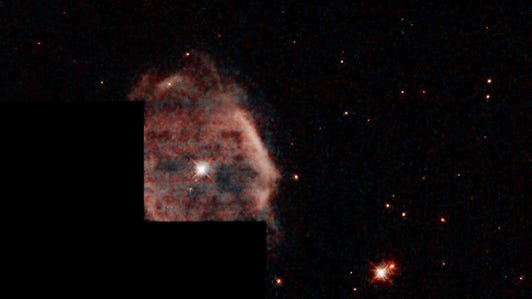
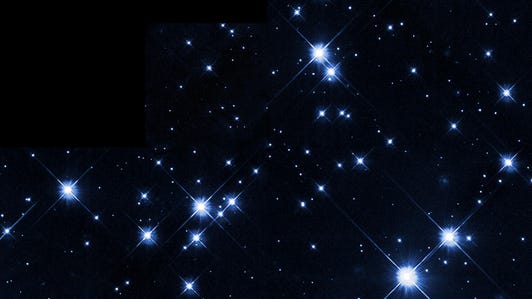

No comments:
Post a Comment